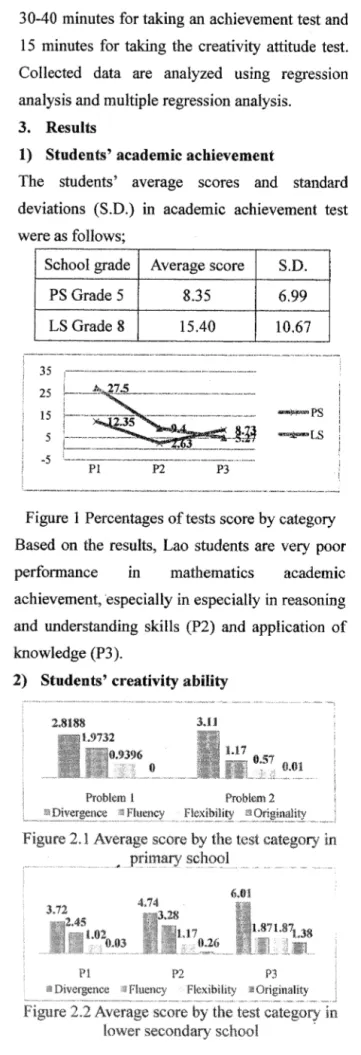Developing of Students' Ability in Mathematics for Primary and Lower
Secondary Schools in Laos
ft~
.
flJi~ft1f~~Mayuly CHAMLEUNSAB 1. Introduction
Even though the Lao Government identified a goal to graduate from the ranks of the least developed countries (LDC) by the year 2020, the education sector in Laos still facing many problems; the lack of textbooks, and education materials, the poor school environment, the lack of qualified teachers and etc. In Mathematics education the primary instructional method in Laos's schools is frontal lecturing, copying contents of textbook on the blackboard and encouraging recitation and memorization. Students are mostly passive recipients of instruction. While there is some opportunity for them to copy exercises to their notebooks, there is comparatively little time. to devote' to practical exercises or application of knowledge. The other issue is to understand well the Lao students in their academic ability and creativity regarding mathematics. Until understanding their present situation in terms of the ability and creativity, we could not provide suitable exercise in a proper way of facilitating the application of their knowledge. In this research, we used the defmition of creativity in terms of creativity in school, as defmed by SAITO (1999a) which we must think of the learning contents of the group of students which they belong to. It is necessary to develop following tests and scales on measurement and evaluation of the achievement, creativity ability and attitude. Therefore, we developed these tests, and administered to students in Laos. The primary part of this
research was to investigate the primary and lower secondary school students' academic achievement, creative ability and attitude in mathematics problem solving in Laos.
2. Research methodology
The research was conducted in 4 Lao primary and 3 lower secondary schools in March 2010. The total student participant is 358 (the total number of primary school student is 149 and lower secondary school student is 209). Academic achievement test, creativity ability and attitude tests were administered to measure students' academic achievement, creativity ability and attitude in mathematics problem solving. The academic achievement tests' contents related to "Size of Angle" and "Triangle and Quadrangle" for primary school (grade 5) and "Size of Angle", "Triangle and Quadrangle", "measurement" and "linear function" for lower secondary school (grade 8). The test questions were grouped into three categories namely PI, P2 and P3 and marked out of 100 for all three categories; a) PI focus on students' knowledge and calculation skills i.e. "solve" questions, b) P2 focus on students' reasoning and understanding skills i.e. "How to solve" questions, and c) P3 focus on questions that deal with relation or application of knowledge. The creativity ability tests' contents related to "Geometric and Measurement" grade 5 and "Geometric, Algebra and Linear Function" for grade 8. The contents of creativity attitude test are related to students' attitude toward learning mathematics. In this research we set the time
355-30-40 minutes for taking an achievement test and 15 minutes for taking the creativity attitude test. Collected data are analyzed using regression analysis and multiple regression analysis.
3. Results
1) Students' academic achievement
The students' average scores and standard deviations (S.D.) in academic achievement test were as follows;
School grade Average score S.D. PS Grade 5 8.35 6.99 LS Grade 8 15.40 10.67
Figure 1 Percentages oftests score by category Based on the results, Lao students are very poor performance In mathematics academic achievement, especially in especially in reasoning and understanding skills (P2) and application of knowledge (P3).
2) Students' creativity ability
Figure 2.1 Average score by the test category in school
PI P2 P3
iii Divergence tl Fluency Flexibility!!! Originality
A V"l'!H"" score by the test category
lower secondary school .
Students' ability in divergence was pretty good, but their ability of both levels is gradually lowering from divergence to originality, especially the ability in flexibility and originality when comparing with divergence.
3) Students' creativity attitude
Students' average score in this test is 85.5 (Grade 5) and 92.8 (Grade 8). The percentage of students' creativity attitude test score by category also shows that they are positive creative in learning mathematics.
Category Grade 5 Grade 8 Divergence 60.8 66.8 Logicality 58.8 63.2 Positivity 67.5 77 Originality 66 76.2 Concentration 62 70.5 Convergence 63 65 Caution 69 76 4. Conclusions
Lao students are very poor performance m
mathematics academic achievement for all categories. In term of creativity test, students' creativity ability IS low especially the
performance to generate original ideas is very weak. However, they are positively creative m
learning mathematics.
More opportunities should be given to students to sense and define problem for themselves, as well as to explore their solutions to given problems, and to generate ideas; looking at the world in different ways and playing with different possibilities and alternative solutions. To improve students' knowledge and understanding skills, teachers can be learnt through to student's weak points through students' incorrect answers and expression to academic achievement test in this study.
